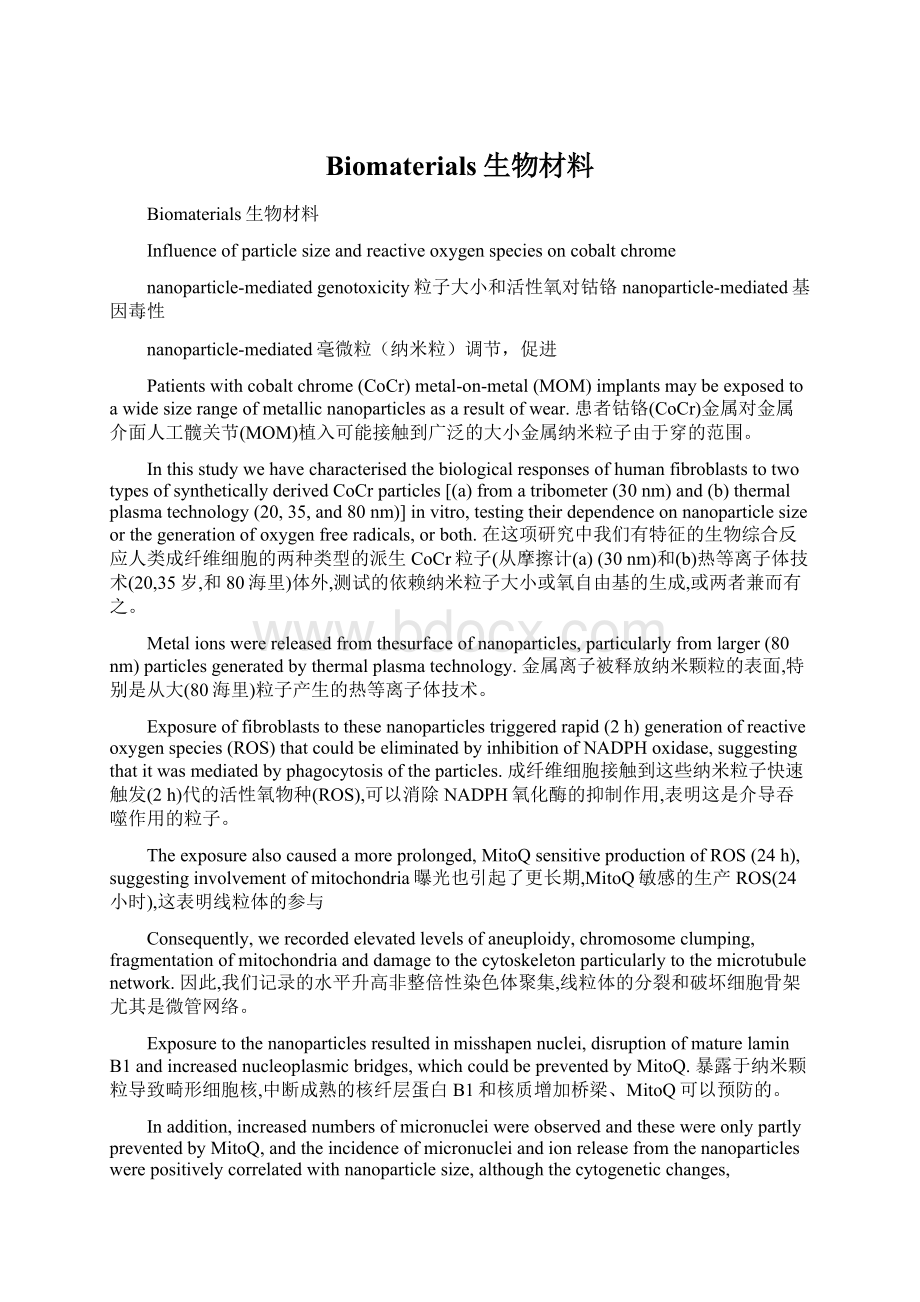Biomaterials生物材料.docx
《Biomaterials生物材料.docx》由会员分享,可在线阅读,更多相关《Biomaterials生物材料.docx(33页珍藏版)》请在冰豆网上搜索。

Biomaterials生物材料
Biomaterials生物材料
Influenceofparticlesizeandreactiveoxygenspeciesoncobaltchrome
nanoparticle-mediatedgenotoxicity粒子大小和活性氧对钴铬nanoparticle-mediated基因毒性
nanoparticle-mediated毫微粒(纳米粒)调节,促进
Patientswithcobaltchrome(CoCr)metal-on-metal(MOM)implantsmaybeexposedtoawidesizerangeofmetallicnanoparticlesasaresultofwear.患者钴铬(CoCr)金属对金属介面人工髋关节(MOM)植入可能接触到广泛的大小金属纳米粒子由于穿的范围。
InthisstudywehavecharacterisedthebiologicalresponsesofhumanfibroblaststotwotypesofsyntheticallyderivedCoCrparticles[(a)fromatribometer(30nm)and(b)thermalplasmatechnology(20,35,and80nm)]invitro,testingtheirdependenceonnanoparticlesizeorthegenerationofoxygenfreeradicals,orboth.在这项研究中我们有特征的生物综合反应人类成纤维细胞的两种类型的派生CoCr粒子(从摩擦计(a)(30nm)和(b)热等离子体技术(20,35岁,和80海里)体外,测试的依赖纳米粒子大小或氧自由基的生成,或两者兼而有之。
Metalionswerereleasedfromthesurfaceofnanoparticles,particularlyfromlarger(80nm)particlesgeneratedbythermalplasmatechnology.金属离子被释放纳米颗粒的表面,特别是从大(80海里)粒子产生的热等离子体技术。
Exposureoffibroblaststothesenanoparticlestriggeredrapid(2h)generationofreactiveoxygenspecies(ROS)thatcouldbeeliminatedbyinhibitionofNADPHoxidase,suggestingthatitwasmediatedbyphagocytosisoftheparticles.成纤维细胞接触到这些纳米粒子快速触发(2h)代的活性氧物种(ROS),可以消除NADPH氧化酶的抑制作用,表明这是介导吞噬作用的粒子。
Theexposurealsocausedamoreprolonged,MitoQsensitiveproductionofROS(24h),suggestinginvolvementofmitochondria曝光也引起了更长期,MitoQ敏感的生产ROS(24小时),这表明线粒体的参与
Consequently,werecordedelevatedlevelsofaneuploidy,chromosomeclumping,fragmentationofmitochondriaanddamagetothecytoskeletonparticularlytothemicrotubulenetwork.因此,我们记录的水平升高非整倍性染色体聚集,线粒体的分裂和破坏细胞骨架尤其是微管网络。
Exposuretothenanoparticlesresultedinmisshapennuclei,disruptionofmaturelaminB1andincreasednucleoplasmicbridges,whichcouldbepreventedbyMitoQ.暴露于纳米颗粒导致畸形细胞核,中断成熟的核纤层蛋白B1和核质增加桥梁、MitoQ可以预防的。
Inaddition,increasednumbersofmicronucleiwereobservedandthesewereonlypartlypreventedbyMitoQ,andtheincidenceofmicronucleiandionreleasefromthenanoparticleswerepositivelycorrelatedwithnanoparticlesize,althoughthecytogeneticchanges,modificationsinnuclearshapeandtheamountofROSwerenot.此外,增加微核的数据观察,这些只是部分预防MitoQ,微核发生率和离子释放的纳米颗粒呈正相关纳米粒子的大小,虽然细胞遗传学变化,核形状和修改ROS没有。
TheseresultssuggestthatcellsexhibitdiversemitochondrialROS-dependentandindependentresponsestoCoCrparticles,andthatnanoparticlesizeandtheamountofmetalionreleasedareinfluential.这些结果表明,细胞表现出多样化的线粒体ROS-dependent和独立应对CoCr粒子,纳米颗粒大小和金属离子的数量发布是有影响力的。
1.Introduction
Orthopaedicpatientswithmetal-on-metal(MoM)hipreplacementsareexposedtoCoCrnanoparticlesasaresultofwearoftheimplant[1e4].骨科金属对金属介面人工髋关节(MoM)髋关节置换患者暴露于CoCr纳米颗粒由于穿的吗e4植入[1]。
Approximately6.7_1012e2.5_1014particles(generally<50nm)aregeneratedbyarticulatingCoCrsurfacesineachpatienteveryyear[5,6].大约6.71012e2.51014粒子(一般<50nm)由阐明CoCr表面生成每个病人每年(5、6)。
Callshavebeenmadefortheestablishmentandvalidationofmaterialcharacterisationprotocolsandbiologicaltestingmethodologiestounderstandthepotentialtoxicityofthesenanoparticles.的电话了建立和验证的材料描述协议和生物测试方法了解的潜力这些纳米颗粒的毒性。
Thereisalsoanincreaseofcirculatingmetalionsinthebloodofthesepatients[5,7e17],whomaybeexposedtometalforupto60yearsaftersurgery.Thisinternalsurgicalexposuretonanoparticlesisdifferentfromtheexternalexposure(suchasenvironmentalpollution/inhalation)asitbypassesmanyofthebody’snaturaldefences,forexamplebymacrophageuptakeorcontactwithfluidsintheairwaysbeforeenteringthebody.还有一个增长循环这些病人的血液中金属离子(5、7e17),可能是谁接触到金属长达60年手术后。
这个内部手术暴露于纳米粒子不同于外部风险(如环境污染/吸入),因为它绕过许多身体的自然防御系统,例如巨噬细胞吸收或接触液体的航空公司在进入身体。
WhileitisnotknownwhetherthereleaseofCoandCrionsisessentiallyfromthewholeimplant,orbycorrosionofweardebrisand/orboth;themechanismsofCo2þ[18e21],andCrions(trivalentandhexavalent)[22e27]toxicityinvitroiswellunderstoodwithoxidativestressmediatedcyto-andgenotoxicityplayingamajorrole.WehavepreviouslyobservedincreasesinaneuploidyinperipheralbloodlymphocytesofpatientswithCoCr-on-CoCrweardebris[28].WealsodemonstratedthatCoCrnanoparticles(30nm)whichweregeneratedbyapin-on-platetribometerweresignificantlymoretoxicthancommerciallyavailablemicronsized(2.9mm)CoCrparticlesinvitro[29],demonstratingthatCoCrparticlesizemaybeakeyfactorgoverningtoxicity.Importantly,theCoCrweardebrisgeneratedinsitufromMoMimplantsisoftenaheterogeneousmixofnanoscaleparticles.虽然不知道Co和铬离子的释放基本上整个植入或腐蚀磨损碎片和/或两者;机制Co2þ万国宫e21[18],和铬离子(三价和六价)(22e27)体外毒性是很好理解的与氧化应激介导cyto-and基因毒性一个主要的角色。
我们曾观察到非整倍性的增加CoCr-on-CoCr患者的外周血淋巴细胞磨屑[28]。
我们还表明,CoCr纳米颗粒(30nm)是由pin-on-plate生成摩擦计毒性比商用微米大小的(2.9毫米)CoCr粒子体外[29],证明CoCr粒子管理毒性大小可能是一个关键因素。
重要的是,CoCr磨屑经常从妈妈植入原位生成异构的混合纳米粒子。
SizedependentbutconcentrationindependenttoxicityofnanoparticleshasbeendemonstratedpreviouslyforothermetaloxidessuchasTiO2,CuO,ZnO[30,31].ThereisverylittleknownaboutthemechanismsoftoxicityofdifferentiallysizedCoCrparticleswithinthenanoscalerange.Thetoxicityofmetaloxidesmayalsobedependentontheextentofoxidativestress[32e34].Inthisstudy,wehaveinvestigatedwhetherthereisarelationshipbetweenthesizeoftheCoCrnanoparticleandtheamountofgenotoxicity.Wehaveusedavarietyofassaystoexplorethis.Wehavealsoexploredtheroleofoxidativestressinthegenotoxicresponse.独立的毒性大小依赖但浓度为其他金属纳米粒子已经证明之前氧化物如二氧化钛、措,氧化锌(30、31)。
很少有机制的差异大小的CoCr粒子的毒性在纳米尺度范围内。
金属氧化物的毒性可能也依赖于氧化应激的程度[32e34]。
在这研究中,我们调查是否有关系CoCr纳米粒子的大小和数量的基因毒性。
我们使用各种各样的分析探讨。
我们有也探讨了作用的氧化应激基因毒性反应。
2.Materialsandmethods
2.1.Preparationandsterilisationofnanoparticles
2.1.1.Preparationofthermalplasma(ThP)particles
Awater-cooledtungstentipandcoppercruciblewereusedascathodeandanodeelectrodes,respectively.ApieceofCoCrdiscof33mmdiameterand10mmthickwasplacedinthewater-cooledcoppercrucible.AdynamicflowofArgasat5L/minwasappliedbetweenthetungstentipandtheCoCrdiscmaintainedwithagapof2mm.AplasmawasthengeneratedbetweenthetungstentipandtheCoCrdiscusingcurrentandvoltagelistedinTable1A.TheplasmacausedtheCoCrdisctoevaporateandthevaporisedgaswasquenchedontoawater-cooledcolumn,wherethenanoparticleswerecollectedforanalysis.Thecompositionofthealloyfromwhichthethermalplasmaparticlesweremade,intermsofbothweight%andatomic%,isshowninTable1B.热等离子体(ThP)粒子的制备水冷钨的小费和铜坩埚被用作阴极和阳极电极,分别。
一块CoCr盘33毫米直径10毫米厚是放置在thewater-cooled铜坩埚。
一个动态的基于“增大化现实”技术的气体流动在5l/钨之间的最小应用技巧和CoCr盘保持空白2毫米。
那时等离子体生成钨提示和CoCr盘之间表1中列出使用电流和电压。
CoCr盘引起的等离子体蒸发,蒸发气体淬火到水冷列收集纳米粒子进行分析。
合金的成分热等离子体粒子,在重量%和原子%,表1b所示。
2.1.2.Preparationofpin-on-plate(PoP)particles
Nanoparticles(29.5_6.3nm)ofCoCralloyweregeneratedusingaflatpin-onplatetribometer.ThecompositionofCoCralloy(ASTMF1537)usedtogenerateparticlesislistedinTable1C.Particlesweregeneratedwithabi-directionalmotionof5.6_10_2ms_1andacontactstressof11MPaovera24hperiodinwater.Theparticleswererecoveredbyfiltrationonto100nmporesized25mmpolycarbonatefiltermembranesandthemassofparticlesonthefiltersdeterminedgravimetrically.Thefilterswereplacedinsterilepyrogenfree-waterandsonicatedinasonicbathfor1hinordertoresuspendandpooltheparticles.粒子制备pin-on-plate(流行)纳米颗粒(29.5-6.3海里)CoCr合金使用平pin-onplate生成摩擦计。
CoCr合金的成分(ASTMF1537)用于生成粒子是表1中列出。
粒子生成的双向运动5.6102ms1和接触应力的11MPa在24小时内的水。
的粒子被过滤恢复到100纳米孔隙大小25毫米聚碳酸酯过滤膜和颗粒的质量过滤器重量分析地决定。
过滤器被置于无菌热原质自由液和sonicated声波浴1h粒子以resuspend和池。
2.1.3.Sterilisation,sonicationandexposures
Themetalnanoparticlesweretransferredintoglassuniversals,weighed,washedin100%ethanolandheatedat180_Cfor3hasamodeofsterilisation.Latexnanoparticlesweresterilisedbyfilteringthrougha0.2mmfilter.Aftersterilisation,thenanoparticleswereresuspendedinserumfreegrowthmediumbysonication(pulsedmode:
7pulseseachof1e2slong)usingatitaniumprobeandSonicsVibraCELLVC130PBsonicator(maximumoutputpower:
130W).Thefibroblastswereexposedtothenanoparticlesatdosesof0.0005mm3/cellto500mm3/celloverarangeoftimepoints(2he5days).冲销,声波降解法和曝光金属纳米粒子被转移到玻璃共性,重,在100%乙醇洗和加热在180C3h作为冲销的模式。
乳胶纳米粒子被通过0.2毫米过滤器过滤消毒。
消毒后,纳米颗粒在血清resuspended自由生长介质声波降解法脉冲(脉冲模式:
7每个1e2年代长)使用钛调查和超音速VibraCELLVC130PB超声发生器(最大输出功率:
130w)。
的成纤维细胞暴露在纳米颗粒在剂量的0.0005mm3/500/mm3细胞细胞吗一系列的时间点(2he5天)。
2.2.Dissolutionofmetalionsintothegrowthmedium
AllCoCrparticleswereincubatedingrowthmediumfor24h,37_C.Attheendoftheincubationperiod,theparticleladenmediumwascentrifugedat14,000rpmfor20min.Thesupernatantwasanalysedfortracemetalbyinductivelycoupledplasmamassspectrometry(ICP-MS)[AnalyticaLtd,Sweden].所有CoCr粒子在生长介质孵化24h,37_C。
结束的时候潜伏期,粒子拉登介质centrifuged在14000rpm20分钟。
分析了上层的电感耦合等离子体的微量金属质谱(icp-ms)分析有限公司、瑞典。
Table1A
Conditionsusedtogeneratethermalplasmananoparticles条件用于生成热等离子体纳米颗粒
SampleCurrent(A)Voltage(V)
20nm35040
34.8nm41040
80nm50040样品电流(A)电压(V)
Table1b
Compositionofalloyfromwhichthermalplasmaparticleswereprepared.
ElementCCoCrFeMnMoNNiSi
Wt%0.0664.328.00.250.506.000.200.200.50
Atomic%0.2962.530.80.260.523.580.820.201.02
2.3.Characterisationofparticlesbytransmissionelectronmicroscopy(TEM)andphotoncorrelationspectroscopy(PCS)描述粒子的透射电子显微镜(TEM)和光子相关光谱(电脑)
ThesizesoftheparticlesweredeterminedbyTEMandPCS.SamplesforTEManalysiswerepreparedbyapplyingadropoftheappropriatedispersionontoa3mmdiameter,carboncoveredcoppergrid.SpecimenswereexaminedonaJeol1200EXmkIITEMoperated